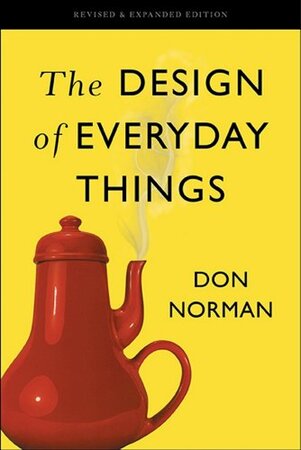
The Design of Everyday Things
“The Design of Everyday Things” by Don Norman is a compelling exploration of the principles of good design and its impact on the usability of everyday objects. Norman, a cognitive scientist and design advocate, delves into the psychology behind human interaction with the world around us, revealing how well-designed objects can enhance our experiences while poorly designed ones can lead to frustration and confusion.
The book begins by highlighting the fundamental concept of affordances, which refers to the perceived possibilities for action that an object or environment provides to its users. Norman argues that objects should have clear and intuitive affordances, allowing users to easily understand how to interact with them. He presents numerous examples of design failures, such as poorly labeled buttons or confusing interfaces, to illustrate the consequences of disregarding affordances.
Norman then delves into the concept of mapping, which involves the relationship between the controls of a device and their corresponding functions. He emphasizes the importance of creating a clear and logical mapping between controls and their intended actions, enabling users to easily understand and predict the system’s behavior. The author provides insightful anecdotes and case studies to illustrate how mismappings can lead to errors and frustration.
In subsequent chapters, Norman discusses the role of feedback in design, highlighting the significance of providing users with timely and informative feedback that confirms their actions and helps them understand the system’s response. He emphasizes the importance of creating clear and perceivable feedback mechanisms, such as visual indicators or auditory cues, to ensure effective communication between the user and the designed object.
The book also explores the concepts of conceptual models and mental models, emphasizing the need for designers to align their conceptual models with the mental models of users. Norman argues that effective design requires understanding how users perceive and conceptualize objects and systems, ensuring that the design matches their expectations and mental frameworks.
Throughout the book, Norman provides thought-provoking examples from various domains, including everyday household items, technology interfaces, and transportation systems. He draws on his vast experience in cognitive science and design to highlight both successful and unsuccessful design practices, guiding readers toward a deeper understanding of the impact of design choices on user experience.
In the later chapters, Norman expands his discussion to address the larger context of design, exploring the role of emotion and aesthetics in shaping user experiences. He argues that design should not only be functional but also evoke positive emotional responses, as aesthetics and emotional appeal significantly impact our perception and satisfaction with a product.
“The Design of Everyday Things” is a comprehensive and insightful exploration of the principles of good design and user-centered thinking. Norman’s engaging writing style, coupled with numerous real-world examples and practical advice, makes this book a valuable resource for designers, engineers, and anyone interested in understanding the impact of design on our daily lives. It serves as a compelling reminder of the importance of thoughtful and user-centric design in creating enjoyable and intuitive experiences with the objects and systems we interact with every day.
“The Design of Everyday Things” by Don Norman is a seminal book that explores the fundamental principles of design and how they shape our daily interactions with objects and systems. With a focus on user-centered design, Norman delves into the psychology of human behavior and cognition to uncover why some designs succeed while others fail miserably.
In this comprehensive and thought-provoking book, Norman takes readers on a journey through various aspects of design, ranging from the layout of physical objects to the usability of digital interfaces. He argues that good design goes beyond aesthetics and should prioritize the needs and capabilities of the users.
The book begins by introducing the concept of affordances, which refers to the perceived properties of an object that suggest how it can be used. Norman emphasizes that designers should strive to create intuitive and discoverable affordances to facilitate smooth interactions. He also highlights the importance of mapping, where the relationship between the controls and the objects they manipulate should be clear and consistent.
Norman then explores the concept of feedback, which plays a crucial role in providing users with information about the state of a system and the consequences of their actions. He discusses the different forms of feedback, such as visible, audible, and tangible, and how they can enhance the user experience. Additionally, he emphasizes the significance of constraints in guiding users towards the correct actions and preventing errors.
One of the key insights of the book is the concept of cognitive load, which refers to the mental effort required to understand and operate a system. Norman argues that well-designed systems should minimize cognitive load by leveraging users’ existing knowledge and providing clear instructions and cues. He also addresses the issue of errors and suggests design strategies to mitigate their occurrence and impact.
In later chapters, Norman delves into the challenges of designing for complex systems and the role of emotions in user experience. He highlights the need for system thinking and the importance of considering the entire user journey to create cohesive and enjoyable experiences. He also emphasizes the emotional aspect of design, as users often form strong connections with products based on how they make them feel.
Throughout the book, Norman provides numerous real-world examples and case studies to illustrate his concepts and principles. He reflects on both successful and failed designs, showcasing how design decisions can have profound impacts on usability, safety, and user satisfaction. From doors and faucets to smartphones and websites, he dissects various everyday objects and interfaces to uncover the underlying design flaws or triumphs.
“The Design of Everyday Things” is not only a guide for designers and engineers but also a valuable resource for anyone interested in understanding the world of design around them. Norman’s engaging writing style and insightful anecdotes make complex design concepts accessible and relatable. The book serves as a call to action, urging designers to embrace human-centered approaches and consider the needs and abilities of users throughout the design process.
In conclusion, “The Design of Everyday Things” is a must-read for anyone involved in design or interested in improving their interactions with the designed world. Don Norman’s expertise and passion shine through as he illuminates the principles of good design and provides practical insights for creating more intuitive, usable, and delightful experiences. By applying the lessons from this book, designers can make a positive impact on the way people interact with the world around them.











